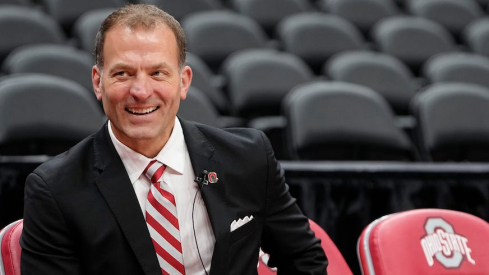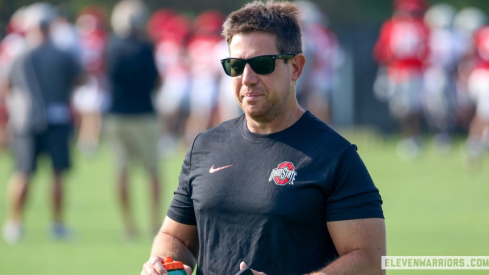
We continue our 2012 analysis and early 2013 preview with a look at Ohio State's wide receivers and tight ends. As with the Buckeye offensive line, OSU's wide receiver corps was a question mark throughout spring and fall practice and the Buckeyes were undoubtedly thin at the position.
But fortunately for the Buckeyes, Corey Brown and Devin Smith emerged as two – if different – threats that contributed to the 12-0 finish. Brown was the player OSU relied on for consistency and to move the chains, while Smith was the vertical threat.
With those two and others returning, this group must continue to develop for OSU's offense to make further strides.
"H" Receiver
It is helpful to examine the wide receiver corps by position and the biggest demarcation is between the slot – or H receiver in Meyer's lingo – and outside personnel.
In Meyer's scheme, the H receiver is one of the most important positions on the offensive side of the ball. He wants a smaller athlete at the position that can make plays in space and run after the catch.
The H is also who the Buckeyes use to beat man coverage. Here's what Coach Hoover wrote about one of Meyer's staple plays, the H option:
H Option is a play designed to get the ball into the hands of the offense's most dynamic playmaker. First it was Paris Warren at Utah, and then at Florida it was Percy Harvin, after whom the position was commonly referred to as the "Percy Position." It is the football equivalent to the basketball play where everybody spreads the court and gets out of the way to let your best player take his guy 1 on 1.
Clearly, H is an important man and should lead the Buckeyes in receptions. Fortunately for Ohio State, Brown emerged to deftly fill this role, finishing 2012 with 60 receptions, including a career-high 12 in the win against Michigan State.
Brown was extremely reliable, catching everything thrown his way and becoming Braxton Miller's security blanket on third down. He was undoubtedly the Buckeyes' primary target in the middle to underneath zones.
This was particularly true on play action and sprint out.
As the season progressed, he also exhibited an ability to run after the catch, and was versatile enough to motion into the backfield to occasionally run outside zone option. And, of course, he also had two crucial punt returns for touchdowns.
Brown emerged as one of the Buckeyes' crucial cogs and was critical to the Buckeyes' success. If he can continue to develop his explosiveness and yards after catch he will be one of college football's top wide receivers. Brown is undoubtedly one of the Buckeye offense's most important returning members for 2013.
Jake Stoneburner also aligned as an interior receiver, though in a different role. Stoneburner would align on the line of scrimmage and effectively function as a flexed tight end (when Stoneburner was in the position Brown would move to flanker or "Z"').
For Stoneburner, it was perhaps not the season some envisioned. It seemed that he was a classic tweener. He did not comfortably fit at any one position as a receiver and he was not the all-around blocker needed to function in the hybrid TE/fullback role.
Plus, in preseason, the coaching staff needed a way to get Zach Boren on the field and had a dearth of bodies at wide receiver. Yet Stoneburner did not have the immediate vertical speed Meyer looked for in his outside wide receivers.
The only consistent thing about Stoneburner's season was inconsistency. This was a result of Stoneburner's own seeming lapses in concentration as well as a somewhat limited pass game that often did not go past the initial option, generally Brown or Devin Smith.
That is not to say, however, that Stoneburner did not make big contributions. Perhaps none was more important than the double slant pass he caught for a game-clinching touchdown against Penn State.
Stoneburner also made a less heralded but perhaps more important contribution in the form of his blocking from that flexed position. He was very effective in blocking smaller defensive backs to create a seal for edge plays, opening the OSU run game.
Y and Z Wide Receiver
The Buckeyes did not get the consistent play from its outside receivers that it did from the H position. Again, this is partly a question of scheme.
Meyer's spread offense is going to feature the inside guy. But it was also a reflection of the Buckeyes' relative dearth of playmakers from the wide receiver position.
Smith was undoubtedly the second option after Brown and OSU's deep threat. He showed immediately that he could beat a defense deep, and his game-winner against Sparty was a thing of beauty.
Once teams began playing Smith with soft coverage, however, he became less effective. This was partly self-imposed with untimely drops. This was unfortunate because Smith also demonstrated an ability to run with the football after the catch.
Promisingly, however, Smith improved on these aspects in the season's last month. In particular, he was effective on flash screens and hitch routes against those soft coverage schemes.
Smith may have the most all-around upside of the Buckeye receivers, and thus if he can develop the other aspects of his game, he can really make a leap forward.
As noted, Brown often lined up on run downs at Z receiver, moving inside on third down. Smith, Brown, and Stoneburner played the vast majority of wide receiver plays. After those three, there was a significant drop-off in snaps.
Indeed, the only other outside receiver playing significant minutes was Evan Spencer. Spencer has good size with good hands and exhibited flashes. But he did not emerge as enough of a threat in a run-heavy offense to gain consistent looks.
Tight End and H-Back (Y)
The Y position went through a drastic shift midseason, as Boren, who received the majority of the reps, moved to defense, providing significantly more playing time to Jeff Heuerman and Nick Vannett. Boren was never a vertical pass threat but was a devastating lead blocker.
Heuerman could not match Boren's ability to lead block and occasionally struggled with reading defensive games. But Meyer commented that Heuerman was one of the best blocking tight ends he had coached and he was very effective from more traditional tight end alignments.
Heuerman was not a significant vertical threat either, but was effective on flood routes off play-action.
Vannett is less the blocker than Heuerman, but quicker and more of a deep pass threat. Vannett generally played, then, when OSU wanted more of a pass-catching threat from the position, as well as in two tight end sets. In particular, OSU utilized Vannett on seam routes.
A Step Forward?
Despite the strides made at wide reciever, no one would assert that the Buckeye receiving corps was the strength of the offense. Ohio State needs similar improvements from year one to year two to more fully realize the offense's potential.
The personnel is there to make that jump. Part of the improvement will come in the form of Miller becoming more consistent, working through his progressions, and moving when his initial reads are not present. But some of it needs to come from the receivers themselves.
As noted, Brown established himself as sure-handed and a reliable threat to move the chains. If he can become more of a home run threat whenever he touches the football, he will become a receiver opposing defenses need to plan for.
OSU also needs consistent play from its outside receiver spots. As noted, Smith has the potential to be an all-around receiving threat, but simply needs to increase his consistency. And OSU needs a reliable third option. Spencer has the size that he could become a good complement on the outside, but needs to demonstrate consistent results. This could also come in the form of the tight ends, whether it be Heuerman, Vannett, or freshman Marcus Baugh.
The bottom line is that the Buckeyes need more playable wide receivers than just two or three guys. Help is also on the way in the form of Jordan Hall's return. Hall has the potential to fill this "H" role in certain down and distances, getting the ball underneath in space and moving between the slot and backfield. This will allow Brown to move outside and present a defense with different matchups.
Incoming freshmen such as Jalin Marshall and Ezekiel Elliott could also potentially fill these multifaceted roles. The upshot for the Buckeyes is that increased playmaking threats should improve the offense's flexibility and allow them to threaten the defense.

